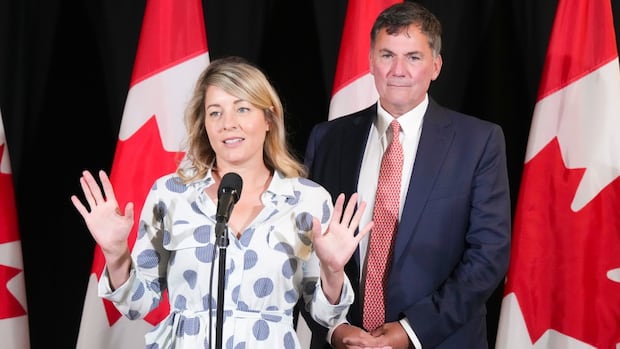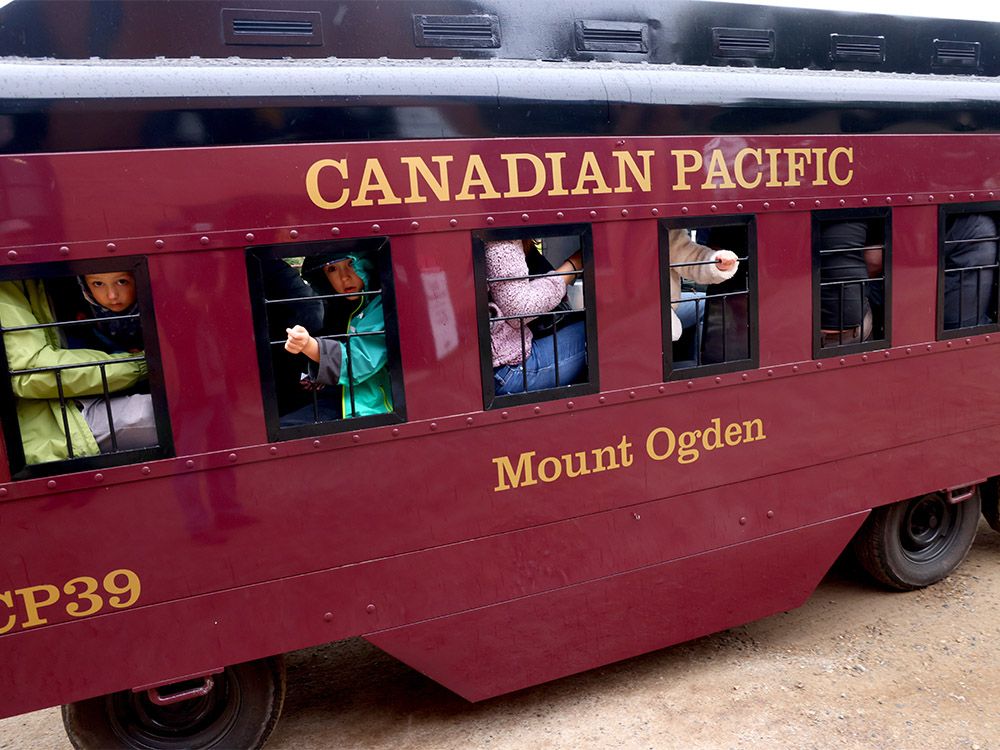New head of Alberta oilsands group wants clarity from Poilievre on industrial carbon pricing

Conservative Leader Pierre Poilievre needs to clarify where he stands on industrial carbon pricing, says the new head of a major oilsands group that aims to bring the industry’s emissions to net-zero largely through the potential construction of a massive carbon-capture project that relies on carbon credits.
“I think it would be very helpful for him to provide greater clarity on that,” Derek Evans said this week in an interview on the CBC podcast West of Centre.
Poilievre has vowed, loudly and repeatedly, that he would scrap the consumer-level carbon tax if his party wins the next federal election. But he has been evasive as to his position on the federally mandated carbon price for industrial-scale emitters.
“The advice I would give Pierre Poilievre is carbon policy is going to be absolutely critical to maintain our standing on the world stage,” Evans said.
“We’re a leader in technology. We should take the opportunity to expand our technology base inside of this and he should be as supportive as he possibly can of that.”
Evans is a former CEO of MEG Energy and was recently appointed executive chair of the Pathways Alliance, a consortium of major oilsands companies that represent about 95 per cent of oilsands production.
The group has vowed to bring the industry’s massive carbon footprint down to net-zero by 2050.
Reaching that goal will be an enormous undertaking.
How to go from 84 megatonnes to net-zero?
The emissions from Alberta’s oilsands totalled 84 megatonnes in 2022.
That’s more than the 79 megatonnes emitted by the activities of every industry in Quebec and all nine million of its people. If Alberta’s oilsands industry were a province, it would be the second-largest emitter of greenhouse gases in Canada, behind only Ontario.
The oilsands are also continuing to grow, both in terms of emissions and output. New records for oil production are being set nearly monthly, and the pace is only expected to accelerate now that the Trans Mountain pipeline expansion has been completed.
So how does the Pathways Alliance propose curbing these enormous emissions and eventually zeroing them out? By capturing, compressing and compartmentalizing the greenhouse gases deep underground.
The consortium’s flagship proposal is to do this on a massive scale, with a 400-kilometre pipeline linking more than 20 facilities to a “carbon storage hub” in northeastern Alberta. Evans said the plan is to have this multi-billion project sequester 40 megatonnes of greenhouse gas annually, once it’s fully operational in 2050.
For context: Canada’s latest national emissions inventory shows that, as of 2022, the entire country had captured and stored a grand total of 7.2 megatonnes of carbon dioxide — since 2017. Most of that was captured by Shell Canada’s Quest facility north of Edmonton.
The Pathways group has not yet made a decision to go ahead with its massive flagship project, but Evans says he personally is committed to making it happen.
“This is probably one of the most important things I’ve done in my career and this is important to me, personally, as well as professionally,” he said.
‘Sick and tired of all of the talk and the lack of action’
Evans said he’s “sick and tired of all of the talk and the lack of action” when it comes to addressing climate change in Alberta’s oilsands.
“The industry for a long time wouldn’t recognize that climate change was an issue,” he said.
“We’ve talked for 40 years about climate change. And we’ve done very, very little about it.”
West of Centre52:44The long and winding road to net zero
The path to net zero by 2050 by the oilsands industry is being spearheaded by what’s known as the Pathways Alliance. West of Centre host Kathleen Petty is joined by Derek Evans, the newly appointed executive chair of Pathways and the former CEO of Meg Energy, to discuss the industry’s long-awaited carbon capture and storage project, and what Evans wants to hear from Pierre Poilievre on carbon pricing. Then, Petty is joined by Emma Graney, who specializes in energy reporting for the Globe and Mail and Andrew Leach, an energy and environmental economist at the University of Alberta.
The Pathways Alliance’s foundational carbon-capture project hinges on several government policies, however, and carbon pricing is just one of them.
Kendall Dilling, the consortium’s president, told CBC News in April that the project is on track to begin operations by 2030 — as long as talks with the federal government wrap up by the end of the year.
Existing uncertainties are still holding things back. For instance, Ottawa has proposed an investment tax credit that would support the project, but Parliament has yet to pass the legislation.
The federal government has also started offering taxpayer-backed carbon contracts for difference, which are agreements that effectively guarantee a floor price for carbon credits, even if a future government were to change the industrial carbon price or wipe it out altogether.
So far, however, only one such contract has been signed, with Calgary-based carbon-capture company Entropy.
Certainty and scale
Evans said the scale of carbon capture the Pathways Alliance is proposing will require bigger thinking about not just the carbon price but also the size of the carbon-trading market.
“What you start to understand is that there isn’t a big enough market for carbon in the province of Alberta,” he said.
Currently, industrial emissions in Alberta are governed by a provincial price on carbon. Alberta was actually the first jurisdiction in North America to put a price on industrial carbon emissions, back in 2007.
In recent years, the federal backstop has helped push Alberta’s carbon price higher, but the regulatory system remains in the purview the provincial government.
“We need a pan-Canadian carbon market,” Evans said. “At some point in time, the volumes of credits that will be generated with Pathways Alliance will overwhelm any single market in its own right.”
Canadian oilsands companies want to build a $16.5-billion carbon capture project near Cold Lake, Alta. Residents fear that pumping millions of tonnes of CO2 underground will endanger their communities.
Even as other carbon-capture proposals have hit the rocks — notably, the $2.4-billion project that Capital Power Corp. cancelled earlier this month — Evans believes the consortium’s mega-project remains feasible with the proper policy certainty from government.
“If we can get this project across the line, which is what I’m committed to, we are going to start decarbonizing the oil and gas business,” Evans said.
“And we will be at net-zero by 2050 with this foundational project that we’ve got on the go.”
At the same time, Evans said he opposes the proposed federal emissions cap on the oil and gas sector, which would mandate emissions to be 35 to 38 per cent below 2019 levels by 2030, as a benchmark en route to Ottawa’s own 2050 net-zero target.
“Our perspective today is those caps are over the top in terms of what we could actually get done in a reasonable fashion,” Evans said.
“I don’t have a problem with the concept of a cap by 2050. We will be there. I just don’t like the gating or the timeline on those gates.”
He figures the industry could more realistically hit Ottawa’s proposed 2030 benchmark “probably somewhere between 2032 and 2035.”
‘Where the rubber meets the road’
Evans’s hesitation to accept interim targets is “interesting,” according to Andrew Leach, an energy and environmental economist at the University of Alberta.
“Those interim targets are where the rubber meets the road,” he said. “It’s the federal government essentially trying to hold the industry to account to say, ‘Get moving with this.'”
And there hasn’t been a lot of movement to date, Leach noted.

He said industry and government have been talking about large-scale carbon capture and storage since 1994 with little to actually show for it, so far.
He said it would have been better to start building smaller-scale projects earlier on instead of swinging for the fences with talk about megaprojects that keep seeing their actual build dates kicked down the road.
“I don’t want to dump on Pathways — like, I really liked the idea of that conversation that we need to decarbonize the oilsands — but, in some ways, the action has to match up with the rhetoric,” Leach said.
That said, Leach noted that rhetoric has changed dramatically from what the industry has said in the past.
“The biggest thing is the change in tone, overall, over a decade on the importance of carbon pricing.”




